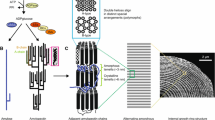Abstract
Ubiquitin is a ubiquitous protein involved in targeting proteins for degradation. Maize pollen was previously reported (Callis and Bedinger 1994) to show extremely low levels of ubiquitin monomer, and developmental significance was attributed to this surprising feature of maize pollen. However, we had previously shown (Muschietti et al. 1994) that tomato pollen had high levels of ubiquitin monomer. Here we show that pollen from most plant families has high levels of ubiquitin monomer. Most grasses tested show reduced levels of ubiquitin monomer, but some maize inbred lines have higher levels of ubiquitin monomer than other inbreds. There was no correlation between the level of ubiquitin monomer and either the monocotyledonous or tri-cellular condition of grass pollen or the dehydrated condition of mature pollen. Since many aspects of pollen development (i.e., wall formation, microspore mitosis, synthesis and storage of mRNAs and proteins, carbohydrates and lipids, dehydration at maturity) are stereotypical among all plant families, the reduced level of ubiquitin monomer in pollen of many grasses cannot be crucial for any feature of normal pollen development.
Similar content being viewed by others
References
Almoguera C, Coca MA, Jordano J (1995) Differential accumulation of sunflower tetraubiquitin mRNAs during zygotic embryogenesis and developmental regulation of their heat-shock response. Plant Physiol 107:765–773
Ausubel FM, Brent R, Kingston RE, Moore DD, Seidman JG, Smith JA, Strahl K (1994) Current protocols in molecular biology. Wiley, New York, pp 10.2.2–10.2.21
Benson LM (1979) Plant classification. Heath, Lexington, Mass
Borkird C, Simoens C, Villarroel R, Van Montagu M (1991) Gene expression associated with water-stress adaptation of rice cells and identification of two genes as hsp70 and ubiquitin. Physiol Plant 82:449–457
Burr B, Burr FA, Matz EC (1994) Mapping genes with recombinant inbreds. In: Freeling M, Walbot V (eds) The maize handbook. Springer, Berlin Heidelberg New York, pp 249–254
Callis J, Bedinger P (1994) Developmentally regulated loss of ubiquitin and ubiquitinated proteins during pollen maturation in maize. Proc Natl Acad Sci USA 91:6074–6077
Clayton WD, Renvoize SA (1986) Genera graminum: grasses of the world. HMSO, London
Courtney SE, Rider CC, Stead AD (1994) Changes in protein ubiquitination and expression of ubiquitin-encoding transcripts in daylily petals during floral development and senescence. Physiol Plant 91:196–204
Ellison MJ, Hochstrasser M (1991) Epitope-tagged ubiquitin. A new probe for analyzing ubiquitin function. J Biol Chem 266:21150–21157
Evans DE, Taylor PE, Singh MB, Knox RB (1992) The interrelationship between the accumulation of lipids, protein and the level of acyl carrier protein during the development of Brassica napus L. pollen. Planta 186:343–354
Ferreira RMB, Ramos PCR, Franco E, Ricardo CPP, Teixeira ARN (1995) Changes in ubiquitin and ubiquitin-protein conjugates during seed formation and germination. J Exp Bot 46:211–219
Fosket DE, Morejohn LC (1992) Structural and functional organization of tubulin. Annu Rev Plant Physiol 43:201–240
Frova C, Taramino G, Binelli G (1989) Heat-shock proteins during pollen development in maize. Dev Genet 10:324–332
Harlow E, Lane D (1988) Antibodies, a laboratory manual. Cold Spring Harbor Laboratory Press, Cold Spring Harbor, NY, pp 498–502
Hershko A, Ciechanover A (1992) The ubiquitin system for protein degradation. Annu Rev Biochem 61:761–807
Hoffman NE, Ko V, Milkowski D, Pichersky E (1991) Isolation and characterization of tomato cDNA and genomic clones encoding the ubiquitin gene ubi3. Plant Mol Biol 17:1189–1201
Hopf N, Plesofsky-Vig N, Brambl R (1992) The heat shock response of pollen and other tissues of maize. Plant Mol Biol 19:623–630
Mascarenhas JP (1989) The male gametophyte of flowering plants. Plant Cell 1:657–664
Mascarenhas JP (1993) Molecular mechanisms of pollen tube growth and differentiation. Plant Cell 5:1303–1314
McCormick S (1993) Male gametophyte development. Plant Cell 5:1265–1275
Muschietti J, Dircks L, Vancanneyt G, McCormick S (1994) LAT52 protein is essential for tomato pollen development: pollen expressing antisense LAT52 RNA hydrates and germinates abnormally and cannot achieve fertilization. Plant J 6:321–338
Pfeifer K, Frank W, Schroder HC, Gamulin V, Rinkevich B, Batel R, Muller IM, Muller WEG (1993) Cloning of the polyubiquitin cDNA from the marine sponge Geodia cydonium and its preferential expression during reaggregation of cells. J Cell Sci 106:545–554
Stanley RG and Linskens HF (1974) Pollen: Biology, biochemistry, management. Springer, Berlin Heidelberg New York
Veierskov V, Ferguson IB, Lay-Yee M (1992) Conjugation of ubiquitin to proteins during greening of etiolated oat plants. J Plant Physiol 139:749–754
Vierstra RD (1993) Protein degradation in plants. Annu Rev Plant Physiol 44:385–410
Watson L, Dallwitz MJ (1992) The grass genera of the world. CAB International, Wallington, UK
Wettern M, Parag HA, Pollmann L, Ohad I, Kulka RG (1990) Ubiquitin in Chlamydomonas reinhardii. Distribution in the cell and effect of heat shock and photoinhibition on its conjugate pattern. Eur J Biochem 191:571–576
Worrall D, Twell D (1994) Pollen maturation: where ubiquitin is not required? Bioessays 16:873–875
Author information
Authors and Affiliations
Rights and permissions
About this article
Cite this article
Kulikauskas, R., Hou, A., Muschietti, J. et al. Comparisons of diverse plant species reveal that only grasses show drastically reduced levels of ubiquitin monomer in mature pollen. Sexual Plant Reprod 8, 326–332 (1995). https://doi.org/10.1007/BF00243199
Received:
Accepted:
Issue Date:
DOI: https://doi.org/10.1007/BF00243199




